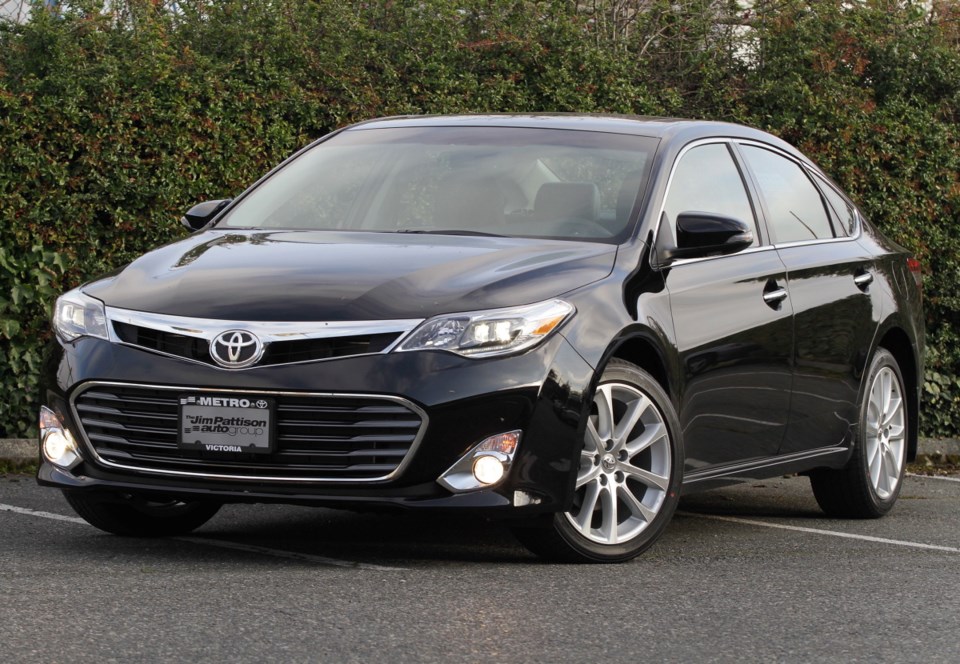The new Avalon is a paradigm shift for Toyota. Previously, buyers looking for luxury typically left the Toyota showroom and stepped into a Lexus showroom.
But the new Avalon is set to change all that. Once the word gets out, I wouldn’t be surprised to find Lexus, as well as BMW, Mercedes and other luxury buyers, dropping into Toyota dealerships to see what the fuss is about.
Before the 2013 overhaul, the Avalon was a forgettable car. It was nice enough — a traditional, large, four-door sedan, festooned with the obligatory leather, chrome and faux wood to qualify as the flagship. But it never caught on. Toyota delivered a mere 427 of them in 2012, putting it dead last in the large-car segment of the Canadian new car market. The Buick LaCrosse outsold it by more than five times.
Hopefully, it can only get better.
Toyota definitely set its sights on younger buyers this time around. The conservative, buttoned-down look is history. The new body is stunning, looking especially good in black. Curves, lines and creases all but shout classy and cool. Suddenly, this is a car a 30- to 40-year-old won’t mind being seen in.
At a starting price of $36,800, it is priced thousands under comparable luxury models, such as the Lexus ES 350. On top of that, the Avalon comes with a long list of standard features typically optional on other luxury cars. This is a familiar road Toyota has gone down before — and it shows the automaker has done its homework.
The Avalon comes in two trim levels, XLE and Limited. We drove a Limited, which sells for $38,900.
The Limited is very well equipped. Some of the highlights include heated and ventilated front seats, a 10-way adjusted driver’s seat, perforated leather, sunroof, HID headlamps, navigation system, and blind-spot and cross-traffic warning systems.
The new body is complemented with a new interior. The cabin is a tasteful collage of chrome highlights, matte surfaces for the controls and acres of soft-touch leather with detailed stitching.
But unlike many new luxury cars, the Avalon is no technological tour de force, seeking to eschew the glitzy electronic controls that frustrate a segment of buyers. Toyota has instead chosen to keep it simple, equipping the car with separate heating and audio controls. This means the 3.5-inch audio/navigation/ back-up screen seems small by comparison.
But simple is sometimes just as good. A driver doesn’t have to switch from screen to screen (or sub-screen) when performing one command after another. One can change a channel on the radio and adjust the temperature in the car, for example, quickly and logically.
But that’s not to say the Avalon isn’t equipped to handle our increasingly connected world. There is a handy bin at the base of the centre console for cellphones with an audio jack, USB port and two power outlets.
Surprisingly, in a cabin replete with power controls, the tilt and telescopic adjustment functions of the steering wheel is manual. This means the steering wheel won’t tilt out of the way automatically when the door is open — a common luxury feature to enhance ingress and egress for drivers.
>From E1
The back seat is spacious, with more than ample legroom for rear passengers. The rear seats don’t fold down to expand cargo capacity. Its only concession is a pass-thru for skis and other long objects — found between the outboard rear passengers.
The powertrain is a carryover from the previous generation, a 3.5-litre V-6 mated with a six-speed automatic. With 268 horsepower, it moves the 1,605-kilogram Avalon with ease. Under a heavy foot, the front-wheel-drive system exhibits mild torque steer.
The Avalon now has paddle shifters as well as the ability to manually change gears with the shifter. It even matches engine revs on downshifts, a small detail appreciated by performance enthusiasts. Drivers can select between Eco/Norm/Sport modes to maximize efficiency or responsiveness. In the Eco mode, one can expect fuel economy to be 9.9 litres per 100 km in the city and 6.4 on the highway. An upcoming hybrid version is sure to drive those numbers further down.
On the highway the Avalon is muted, thanks to efficient sound insulation and a slippery profile — boasting a drag coefficient of 0.28 — that cuts through the air. It is also one of the few cars that can be comfortably driven at highway speeds with the sunroof open.
Engineers have also been busy with the suspension. Gone is the day of driving a land yacht. A stiffened suspension keeps body roll in check, transforming the handling attributes of the car. It’s not in the same league with some rear-wheel-drive luxury cars, but back country roads are now more entertaining to manoeuvre compared with the past.
The Avalon has finally come into its own as a genuine luxury car — without a luxury badge. People trading up from their Camrys finally need not step out of the showroom any more.
